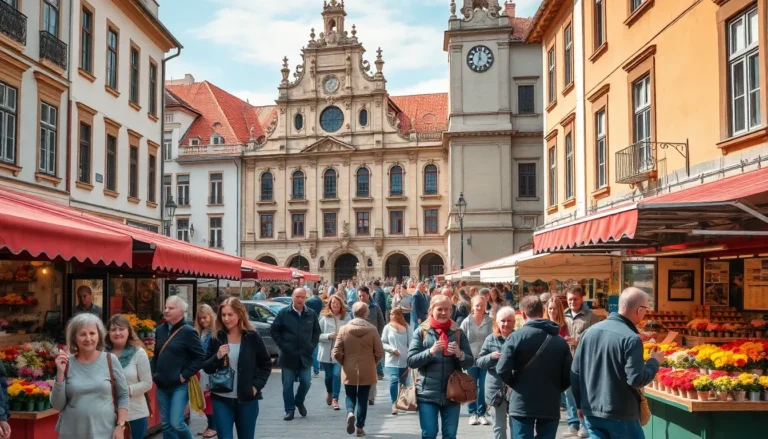In a world where everyone’s shouting for attention, hyperlocal content is the quiet genius that speaks directly to the heart of communities. Imagine a neighborhood newsletter that knows your favorite coffee spot and the best place to snag tacos at 2 AM. It’s not just content; it’s a love letter to local life, connecting people to the stories, events, and businesses that matter most to them.
As the digital landscape evolves, brands are discovering that one-size-fits-all strategies simply don’t cut it anymore. Hyperlocal content is the secret sauce that helps businesses stand out in a crowded market. By tapping into the unique quirks and needs of specific communities, brands can build trust and loyalty like never before. So buckle up; it’s time to explore why hyperlocal content isn’t just a trend—it’s the future of engaging audiences and driving meaningful connections.
Table of Contents
ToggleWhat Is Hyperlocal Content?
Hyperlocal content refers to information that caters to specific geographic areas, focusing on the unique needs, interests, and preferences of local communities. This content type covers topics relevant to neighborhoods, towns, or districts, establishing a direct connection with local residents. By emphasizing localized topics, brands cultivate a deeper relationship with their audience.
Brands can use various formats when creating hyperlocal content, including blog posts, social media updates, and newsletters. Local events, community stories, and area-specific news often serve as excellent topics. Such content fosters engagement and promotes a sense of belonging among residents.
Local optimizations in search engines boost visibility for hyperlocal content. When users search for products or services in their vicinity, hyperlocal content appears more prominently in search results. By targeting local keywords and implementing geo-tagging strategies, businesses can enhance their online presence and attract local customers.
Examples of effective hyperlocal content include restaurant reviews that highlight neighborhood eateries and profiles of local artists. Both offer insights into the community’s culture, drawing attention from both residents and visitors. Moreover, creating content that resonates with local values strengthens brand loyalty.
Utilizing hyperlocal content represents a strategic way for brands to differentiate themselves from competitors. When businesses address specific community concerns, strong connections form, leading to increased trust and engagement. Addressing local topics is not just beneficial; it fosters loyal relationships that can drive long-term success.
Importance of Hyperlocal Content
Hyperlocal content plays a vital role in connecting businesses with their communities. Brands that invest in this approach enjoy various advantages.
Community Engagement
Community engagement thrives through hyperlocal content. This strategy speaks directly to local audiences, fostering a sense of belonging. By highlighting local events, businesses create conversations among residents. Sharing stories about community members, such as profiles of local artists or entrepreneurs, cultivates connections. This type of content encourages customers to participate and contribute, enhancing loyalty. Engaged customers share experiences on social media, expanding the reach of local businesses. Creating content that resonates builds trust and strengthens brand affinity within neighborhoods.
Local SEO Benefits
Local SEO benefits arise from effective hyperlocal content creation. Relevant content improves visibility in search results, particularly for users searching for nearby services. Optimized content with location-based keywords appears more frequently in local searches. Businesses that embrace hyperlocal strategies find themselves ranking higher on search engines. For instance, including location-specific terms in blog posts or social media updates ensures discoverability. These strategies establish an authoritative online presence. As more consumers seek localized information, the emphasis on hyperlocal content becomes increasingly essential for success.
Types of Hyperlocal Content
Hyperlocal content includes various formats that cater to specific geographic areas. It plays a crucial role in connecting communities through tailored information.
News Articles
News articles focus on local happenings, providing timely updates about nearby events and issues. These pieces cover topics such as school board meetings, city council actions, and community advocacy efforts. Residents often appreciate updates on local sports teams and public service announcements. By articulating local news, brands position themselves as trusted sources of information. Engaging headlines drive reader interest, while in-depth reporting fosters discussion among community members. Localized news articles enhance visibility for businesses in search results, establishing authority in their respective markets.
Events Listings
Events listings showcase upcoming activities within a specific region, inviting community participation. These listings include festivals, art exhibits, farmers markets, and workshops. They provide essential information, such as dates, times, and locations. Individuals appreciate easy access to information about local gatherings, encouraging attendance and interaction. Utilizing visually appealing formats enhances user experience and engagement, as people quickly scan for relevant opportunities. Promoting an event can greatly increase its reach through social media shares, attracting larger audiences. Accurate event listings position businesses as integral parts of community life, boosting visibility and consumer trust.
Business Directories
Business directories serve as comprehensive resources for local services and offerings. They include essential information about companies, such as contact details, specializations, and customer reviews. When potential customers look for nearby services, a well-organized directory becomes invaluable. Accurate listings help users find what they need quickly, driving foot traffic to local businesses. Additional features like rating systems and customer feedback enhance credibility, guiding informed decision-making. Highlighting each business’s unique selling points reinforces the connection between services and community needs. Effective directories ultimately strengthen local economies by supporting diverse businesses and fostering consumer loyalty.
Creating Effective Hyperlocal Content
Creating effective hyperlocal content involves understanding and connecting with local audiences. This approach improves community engagement and fosters loyalty.
Identifying Target Audience
Knowing the target audience is vital for creating impactful hyperlocal content. Segmenting audiences by demographics, interests, and behaviors helps tailor messages. Gathering data from social media and local surveys provides insight into community preferences. Understanding local culture and values allows brands to resonate on a personal level. Engaging with community members through events or online forums enhances this connection. Direct communication with residents reveals specific needs and concerns, making content more relevant. As a result, businesses should prioritize building relationships with locals to create content that truly reflects the community.
Utilizing Local Keywords
Local keywords significantly enhance the visibility of hyperlocal content. Researching terms that residents commonly use ensures the content ranks well in search results. Including these keywords in titles, headings, and body text increases discoverability, attracting local traffic. Utilizing tools like Google Keyword Planner or Ahrefs aids in identifying effective keywords. Crafting content around local events or landmarks makes it more relatable and engaging. Integrating these keywords naturally within the content maintains readability while optimizing for search engines. Businesses should consistently update their keyword strategy based on search trends to remain relevant and competitive.
Challenges in Hyperlocal Content
Hyperlocal content faces various challenges that can impact its effectiveness and reach. Understanding these obstacles is crucial for brands aiming for successful implementation.
Competition
Numerous businesses pursue hyperlocal strategies, intensifying competition for audience attention. Local brands and global corporations both recognize the value of community engagement. Differentiation becomes essential for standing out in saturated markets. Successful hyperlocal content emphasizes unique aspects of services and products that resonate with local cultures. Brands can also leverage partnerships with local influencers to enhance visibility. Crafting distinct narratives around local events or stories further fosters community interest. Ultimately, continuous evaluation of competitors helps brands adapt strategies and maintain relevancy.
Resource Limitations
Resource constraints often hinder the production of effective hyperlocal content. Limited budgets restrict the extent of outreach and creative endeavors. Smaller businesses may struggle to allocate sufficient funds for high-quality content creation. Additionally, manpower limitations impact the ability to consistently generate fresh and engaging content. Teams lacking expertise in local SEO may find it challenging to achieve desired visibility. Utilizing user-generated content emerges as a cost-effective strategy for enriching brand narratives. Collaborating with local organizations facilitates access to resources and insights that benefit content development. Emphasizing efficiency and creative solutions mitigates resource-related challenges.
Hyperlocal content is a powerful tool for brands looking to forge deeper connections with their communities. By focusing on local interests and needs, businesses can create meaningful engagement that resonates with their target audiences. This approach not only fosters loyalty but also enhances visibility in an increasingly competitive landscape.
As consumers continue to seek personalized experiences, investing in hyperlocal strategies becomes essential for long-term success. By embracing the unique characteristics of their communities, brands can differentiate themselves and build lasting relationships that drive growth. Adapting to local preferences and leveraging community insights will ensure that hyperlocal content remains a vital aspect of effective marketing strategies.






